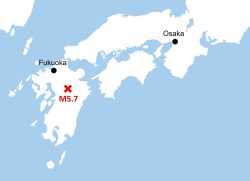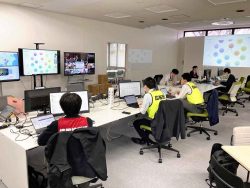
Otsuma Women’s University, which plans to establish a new data science faculty in fiscal 2025, is seen in Chiyoda Ward, Tokyo, on Friday.
20:00 JST, July 23, 2023
Japanese universities are expanding their science curriculums in a bid to survive as the chronically low birth rate cuts into the overall number of students. With the government working to boost the development of human resources in the digital, decarbonization and other fields, significant changes may lie ahead for the traditional structure of universities, where the majority of students have been liberal arts majors in the past.
According to government estimates, there will be a shortage of up to 790,000 personnel with IT skills by 2030. In order to develop such human resources, the government decided last December to create a ¥300 billion fund aimed at setting up or expanding 300 science faculties by fiscal 2032.
The Education, Culture, Sports, Science and Technology Ministry has established a package of two support programs. It has selected a total of 118 universities and technical colleges, with some schools in both programs, and will support their efforts to expand their science, technology and agriculture faculties, as well as graduate programs in these fields.
Sixty-seven entities were chosen for one of the two support programs that excludes national universities. The ministry will provide up to about ¥2 billion per entity as an initial investment for efforts including the establishment and reorganization of faculties and departments, and increases in their capacity.
About 20 of these universities have never had a science faculty. Among them is Maebashi-based Kyoai Gakuen University, which plans to open a “digital green” faculty in fiscal 2026.
“To survive, we need to draw more attention from more prospective students. We applied to the program out of our concern over the future,” said university president Akio Omori.
Higashi Nippon International University, based in Iwaki, Fukushima Prefecture, plans to set up a “digital creation” faculty, and to train human resources in the digital field to contribute to the recovery from the nuclear power plant accident.
Universities are experiencing growing financial difficulties due to the declining birth rate. According to a fiscal 2022 survey by the Promotion and Mutual Aid Corporation for Private Schools of Japan, 47.5% of the private universities that responded said they had fewer applicants than available slots.
The situation is particularly serious for private women’s universities, of 70% were experiencing a shortage of applicants.
Tokyo-based Otsuma Women’s University plans to establish a data science faculty in fiscal 2025, where students will learn how to collect, organize and analyze big data.
“The number of applicants for humanities and home economics is decreasing,” said President Masanao Ito. “Thinking about what is necessary for women’s universities as schools fall by the wayside, we applied for this program.”
Securing teaching staff
In the other support program, the education ministry plans to support graduate and undergraduate schools that are increasing their capacity to develop highly skilled human resources in digital fields who can work immediately. Grants of up to about ¥1 billion will be provided to such schools that have already started developing human resources in this area.
A total of 51 schools were selected for this program, including leading national universities such as the University of Tokyo and Osaka University.
Seven entities were selected for grants, which will provide additional funding of up to ¥1 billion. Among them, Shiga University, the first university in Japan to establish a data science faculty, plans to take measures to strengthen the faculty by increasing the number of students by 50%.
However, there are challenges involved in shifting to science.
Of the faculties and departments that are scheduled to be newly established or restructured, 60% are digital-related. The creation of a succession of digital-related faculties could lead to a shortage of teaching staff.
The ministry has introduced a new system that allows faculty members to teach at multiple universities and faculties, without being tied to a single institution. It is vital to make this system known to the public and increase the mobility of teaching personnel.
“While it’s necessary to develop human resources with science skills, some fear that faculties will simply be given new names,” University of Tsukuba Prof. Motohisa Kaneko said. “There needs to be a mechanism for the government to continuously check the effectiveness of the plan.”
"Society" POPULAR ARTICLE
-

M4.9 Earthquake Hits Tokyo, Neighboring Prefectures
-

M7.5 Earthquake Hits Northern Japan; Tsunami Waves Observed in Hokkaido, Aomori and Iwate Prefectures
-

Tsukiji Market Urges Tourists to Avoid Visiting in Year-End
-

Israeli Tourists Refused Accommodation at Hotel in Japan’s Nagano Pref., Prompting Protest by Israeli Embassy and Probe by Prefecture
-

M5.7 Earthquake Hits Japan’s Kumamoto Pref., Measuring Upper 5 Intensity, No Tsunami Expected
JN ACCESS RANKING
-

Keidanren Chairman Yoshinobu Tsutsui Visits Kashiwazaki-Kariwa Nuclear Power Plant; Inspects New Emergency Safety System
-

Imports of Rare Earths from China Facing Delays, May Be Caused by Deterioration of Japan-China Relations
-

University of Tokyo Professor Discusses Japanese Economic Security in Interview Ahead of Forum
-

Japan Pulls out of Vietnam Nuclear Project, Complicating Hanoi’s Power Plans
-

Govt Aims to Expand NISA Program Lineup, Abolish Age Restriction






















